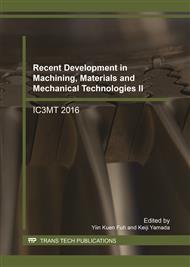p.161
p.171
p.178
p.185
p.191
p.199
p.205
p.211
p.217
A New Procedure for Determining Minimum Sampling Points for Tolerance Evaluation of High Precision Mechanical Parts
Abstract:
In geometric and dimension tolerance investigations, especially for high precision mechanical parts, the accuracy of measurement is very important. The major equipment for the measurement is the coordinate measuring machine (CMM). However, the recommended strategies for evaluating tolerance values of geometric and dimension cannot be applied with high precision mechanical parts. Hence, in this research, the researcher introduced a new procedure that could evaluate geometric and dimension tolerance values of high precision mechanical parts accurately. This new procedure can determine the minimum sampling point for evaluating geometric and dimension tolerance values by using some performance information on the mechanical parts of the machine. This information was the waviness of the production machine’s motion. In order to evaluate the potential of new procedure, the flatness of test piece was made according to the ISO 10791-7-A160 standard as a case study. This test piece was made from the CNC milling machine (Chevalier 2040 VMC), and the waviness of the CNC milling machine’s motion was counted from the performance testing result measured by the double ball-bar model Renishaw QC10. By comparing flatness obtained by recommended and new procedures, experimental results indicated that the new procedure showed its potential in estimating the flatness.
Info:
Periodical:
Pages:
191-196
Citation:
Online since:
August 2017
Price:
Сopyright:
© 2017 Trans Tech Publications Ltd. All Rights Reserved
Share:
Citation:


